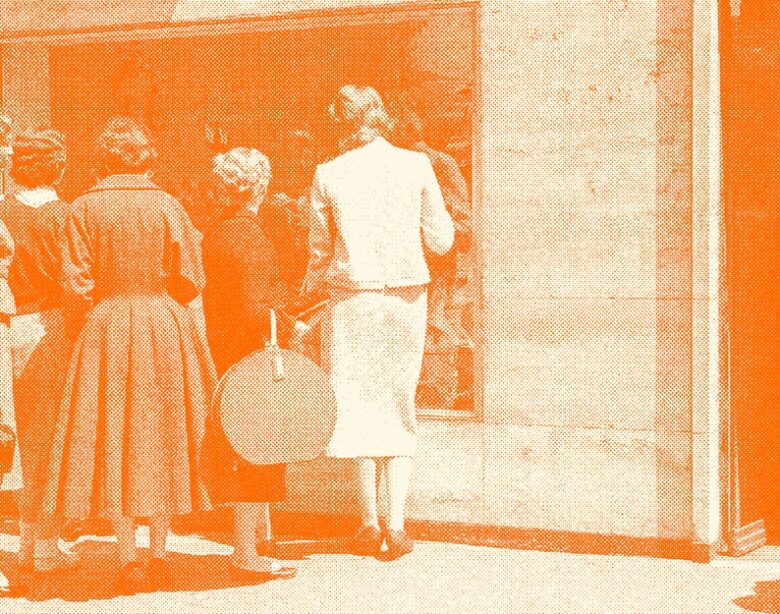[ad_1]
This is the Time-Travel Thursday edition, a journey through. atlantic oceanA storehouse to contextualize the present and reveal delightful treasures. Register here
In the year 1931 Atlantic A contributor named Frances Taylor begged the store to take her money. Long rant Her story about a shopping trip gone wrong describes a failed attempt to buy pajamas. (The one she found didn’t have a wallet—a disaster—and wasn’t her size); Lamps that are yellow or blue (There is only one tube. “Pink and broken,” she said); and other items Mostly on her list “Busy women have money to spend. Make it easier for them to buy and they will spend,” she wrote.
Taylor offers some advice. Both realistic and not so. How could department stores in that era provide more convenience to customers? But most interesting is her description of the problem: “I don’t like shopping. But I like to buy.” It seems that what Taylor dreams of is a life where she makes instant purchases without thinking. If only she could spend five minutes on Amazon.
But the department store experience of the 1930s is all too familiar to our era of one-click online shopping. In a sharp response to Taylor’s anti-shopping remarks a few months later, Contributors Helen Peffer and Juna Newton argue that for wealthy shoppers Impulse buying is far too easy. “Currently, most department stores operate under the policy. ‘The customer is always right,’” they observed. One result of this policy is excessive returns: “Well-to-do” female shoppers “purchase seven ties and return six,” they wrote. “They call or write asking the driver to call and pick them up. Toothpaste, cigarettes, toilet paper, or two rolls of dental floss” are the resources needed to return many items free of charge. It’s a problem with department stores. (Among the examples of articles about wild returns: “In a small town in New Jersey There was a woman who bought underwear for her husband in October 1929 and asked to return them in November 1930. She said they were not ‘comfortable to wear’)
Product returns have started to increase since then. But today’s stores have found a way to free themselves from some of the logistical and financial burden. Amanda Mull reported last year that many brands beginning to charge customers a return fee or require them to cover the cost of returning merchandise (ASOS, H&M and Zara are among the latest popular stores to charge returns fees to some customers) “Convenience Convenience is often expensive for someone,” she wrote. “In most internet eras, Each buyer is not responsible for the cost. But it will start to change slowly.”
Mull noted that the opportunity to pay for returns might cause shoppers to spend more time thinking before making a purchase, that is, if they document a company’s return policy in the fine print. “Shopping online has never been this easy. It’s so seamless and so easy. So easy, in fact, we might all be better off with a few more rounds of speed,” she wrote in another article last year. I heard Taylor’s voice protest: Just let me give you my money! But sometimes people don’t really intend to buy. without having to endure purchasing things first
atlantic oceanIts archive is a reminder of a time when shopping was often a public and social experience. In a 1931 article, Peffer and Newton noted that “It may be true for most returnees that they buy things they don’t need or want. Just out of a natural love of shopping, they consider shopping more of a distraction than a serious business.” Shopping is an activity in itself. This attracts even shoppers who don’t intend to keep their purchases.
And many shoppers care about how others buy their products: In this hilarious story of her first trip to a supermarket in 1954, writer Weare Holbrook delighted in slapping herself among the crowd. By avoiding prying eyes in a small grocery store. “The average adult man,” he wrote, “can’t bring himself to easily ask the grocer” for items like Kinky Winx cereal, Whipsy Doodle salad dressing, Dreamboat soap, O-So-Lushus cake mix, oil. Lover Boy Pork and Icky Crab Pre-Whipped Cream” He notes that the supermarket’s advantage over smaller competitors is “intangible.”
Of course, nowadays Grocery shopping is one of the only types of shopping that still happens in public on a regular basis. At least until now Grocery delivery service Take over completely The rest of our shopping usually happens on our phones. While we wait in line to buy coffee or read a book before bed. (But I admit I’m one of those Millennials who Settings to make a large purchase with my laptop) we have lost The “acceleration” which is a necessary pause when we ask ourselves: Do I need this? Do I need this? Can I afford this? Thinking about those questions will not make us full Control our product purchasing decisions Because algorithms and marketing strategies work overtime to tell us what we want. But taking back a little independence might make that final purchase click feel better.
[ad_2]
Source link



